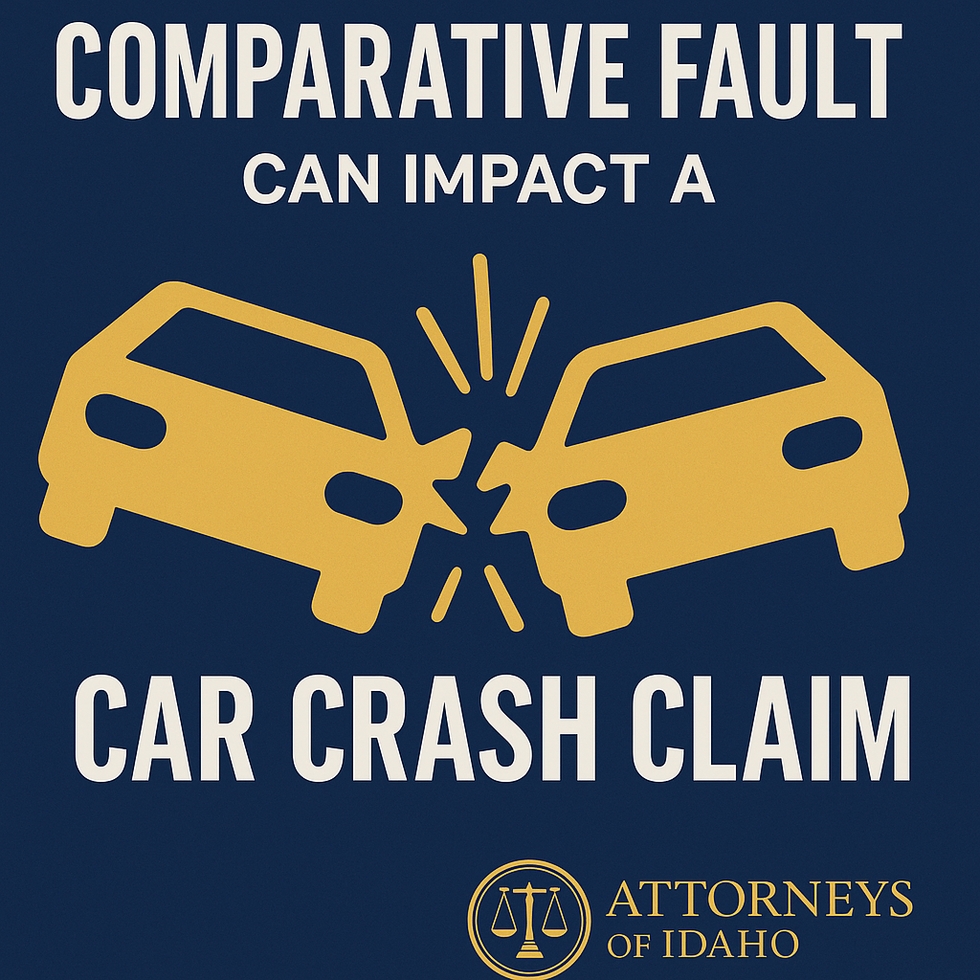
If you’ve been injured in a car accident in Idaho, one of the first legal questions you may encounter is this: Who was at fault? The answer isn’t always black and white. In many cases, more than one party—including possibly you—may share some blame. That’s where Idaho’s comparative fault rules come into play. Understanding how these rules affect your personal injury claim is crucial if you want to recover the maximum compensation available under the law.
This post breaks down Idaho’s comparative fault system, how it applies to car accidents, and what it means for your ability to recover damages.
What Is Comparative Fault?
Comparative fault, sometimes called comparative negligence, is a legal doctrine used to assign responsibility in accidents where more than one party is at fault. Rather than assigning full blame to a single party, a judge, jury, or insurance adjuster can allocate percentages of fault to multiple parties involved in the crash.
Each party’s financial responsibility is then determined based on their percentage of fault.
Idaho’s Modified Comparative Fault Rule
Idaho follows what’s known as a modified comparative fault system with a 50% bar rule, codified in Idaho Code § 6-801. Here’s how it works:
- If you are 50% or more at fault, you cannot recover any compensation.
- If you are less than 50% at fault, you can recover damages, but your total compensation will be reduced by your percentage of fault.
This system is intended to strike a balance—it allows injured people to recover damages even if they were partially to blame, but it limits recovery if they were mostly responsible.
How Comparative Fault Works in Practice
Let’s say you were rear-ended at a red light in downtown Boise, but you had non-functioning brake lights at the time of the accident. The other driver claims they couldn’t see that you had stopped.
In this case, an investigation may determine you were 20% at fault due to the faulty brake lights, while the other driver was 80% at fault for following too closely and not stopping in time.
If your total damages are $100,000, your compensation would be reduced by 20%, and you’d receive $80,000.
But if the evidence showed you were 55% at fault, you would recover nothing under Idaho’s 50% rule.
How Fault Is Determined
Determining fault involves collecting and analyzing evidence, including:
- Police reports
- Witness statements
- Traffic citations
- Surveillance or dashcam footage
- Accident reconstruction reports
- Vehicle damage and skid mark analysis
Insurance adjusters often make an initial fault determination, but these findings are not binding. If a settlement isn’t reached, a judge or jury can make the final call. At Attorneys of Idaho, we always push for jury trials rather than a court trial with just the judge.
Why Comparative Fault Matters in Settlement Negotiations
Even if your case never goes to trial, Idaho’s comparative fault rule influences the settlement process. Insurance adjusters will assess your share of fault early and use it to justify lower settlement offers.
For example, if they believe you were 40% responsible for the crash, they’ll only offer 60% of the full value of your damages. That’s why it’s important to present a well-supported claim and dispute any excessive fault assignments.
Common Scenarios Where Comparative Fault Is Applied in Idaho
Here are a few typical situations where Idaho’s comparative fault rule is often used:
- Intersection Accidents
In cases where two drivers enter an intersection at the same time—say, one running a red light and the other speeding—fault may be split between them. - Lane Change Collisions
When two vehicles collide during a lane change, investigators may find that both drivers failed to check blind spots or signal properly. - Weather-Related Accidents
In Idaho’s winter months, icy roads contribute to many accidents. If one driver was speeding and another failed to maintain a safe distance, both may share fault. - Pedestrian Accidents
If a pedestrian crosses outside a crosswalk at night while wearing dark clothing, and a driver fails to see them in time, both parties could bear some responsibility.
Can Comparative Fault Be Disputed?
Yes. If you’re assigned a share of the blame that you believe is inaccurate, you have the right to contest it.
Ways to challenge a fault determination include:
- Presenting eyewitness testimony
- Hiring an accident reconstruction expert
- Producing medical records that clarify the timing and extent of injuries
- Demonstrating inconsistencies in the other driver’s account
Accurate evidence is key to shifting fault percentages in your favor.
Comparative Fault in Multi-Vehicle Accidents
Multi-vehicle crashes—such as pileups on I-84—add another layer of complexity. Multiple drivers may share fault, and each one’s percentage affects the others’ recovery.
For example, in a three-car accident:
- Driver A is found 10% at fault
- Driver B is 30% at fault
- Driver C is 60% at fault
Drivers A and B can recover damages (reduced by their own percentages), but Driver C cannot recover anything because they’re over the 50% threshold.
The Bottom Line
Idaho’s comparative fault rule plays a central role in personal injury cases. Even if you were partially at fault in a car accident, you may still be eligible to recover significant compensation—as long as you’re less than 50% responsible.
However, the way fault is allocated can dramatically affect the value of your claim. That’s why documenting your accident thoroughly, challenging any disputed liability, and understanding your legal rights under Idaho law are essential steps in protecting your financial recovery.
Understanding Idaho’s comparative fault rules can significantly impact the outcome of your car accident claim. If you’re facing uncertainty or disputes regarding fault in your accident, don’t navigate these complexities alone. Reach out today to schedule a free, no-obligation consultation. Our knowledgeable team can answer your questions, review your situation, and help ensure you’re fairly represented. Call us or schedule your consultation online, and take the first step toward securing the compensation you deserve.

